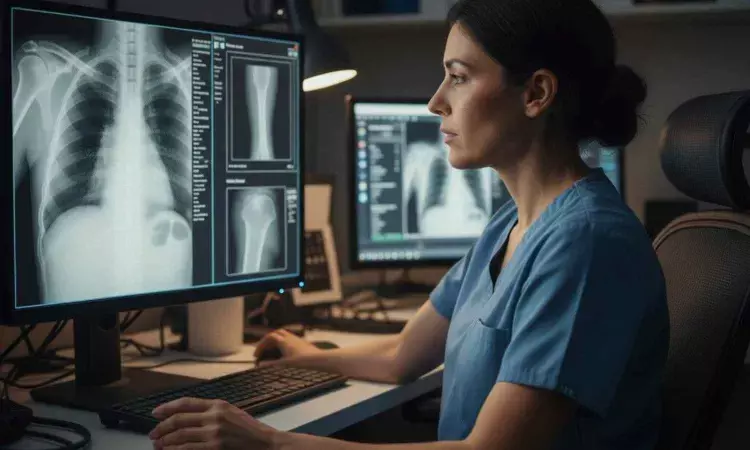- Home
- Medical news & Guidelines
- Anesthesiology
- Cardiology and CTVS
- Critical Care
- Dentistry
- Dermatology
- Diabetes and Endocrinology
- ENT
- Gastroenterology
- Medicine
- Nephrology
- Neurology
- Obstretics-Gynaecology
- Oncology
- Ophthalmology
- Orthopaedics
- Pediatrics-Neonatology
- Psychiatry
- Pulmonology
- Radiology
- Surgery
- Urology
- Laboratory Medicine
- Diet
- Nursing
- Paramedical
- Physiotherapy
- Health news
- Fact Check
- Bone Health Fact Check
- Brain Health Fact Check
- Cancer Related Fact Check
- Child Care Fact Check
- Dental and oral health fact check
- Diabetes and metabolic health fact check
- Diet and Nutrition Fact Check
- Eye and ENT Care Fact Check
- Fitness fact check
- Gut health fact check
- Heart health fact check
- Kidney health fact check
- Medical education fact check
- Men's health fact check
- Respiratory fact check
- Skin and hair care fact check
- Vaccine and Immunization fact check
- Women's health fact check
- AYUSH
- State News
- Andaman and Nicobar Islands
- Andhra Pradesh
- Arunachal Pradesh
- Assam
- Bihar
- Chandigarh
- Chattisgarh
- Dadra and Nagar Haveli
- Daman and Diu
- Delhi
- Goa
- Gujarat
- Haryana
- Himachal Pradesh
- Jammu & Kashmir
- Jharkhand
- Karnataka
- Kerala
- Ladakh
- Lakshadweep
- Madhya Pradesh
- Maharashtra
- Manipur
- Meghalaya
- Mizoram
- Nagaland
- Odisha
- Puducherry
- Punjab
- Rajasthan
- Sikkim
- Tamil Nadu
- Telangana
- Tripura
- Uttar Pradesh
- Uttrakhand
- West Bengal
- Medical Education
- Industry
Assessing glenoid orientation on axillary view: a novel technique using the posterolateral acromion-to-coracoid line

In shoulder arthroplasty, three-dimensional computed tomography (3D CT) has become the gold standard for preoperative version assessment. Meanwhile, postoperative version is usually evaluated using radiographs (XR), in particular an axillary view, in which the view of the scapular body is often truncated, preventing the scapular plane from being used as a reference.
Michael Hachadorian et al introduced the posterolateral acromion-to-coracoid (PLAC) line, which can be assessed on a standard truncated axillary radiograph. The study has been published in ‘International Orthopaedics’ journal.
Forty-six shoulders were studied. Four angles were measured including 3D CT (CT Version), 3D CT PLAC line to glenoid face angle (CT PLAC-GFA), 2) radiographic PLAC line to glenoid face angle (XR PLAC-GFA), and 3) the radiographic glenoid vault line to glenoid face angle (XR GV-GFA). Variation and linear relationship between these angles were calculated.
The key findings of the study were:
• Of the 46 patients, 27 (59%) were male.
• The mean age at the time of surgery was 62.6 years old (IQR = 12.1, 57.1 to 69.3).
• The primary indication for arthroplasty was osteoarthritis (46%). Of the osteoarthritic shoulders, the primary glenoid morphology was Walch B2 (50%)
• The mean difference between CT PLAC-GFA and XR PLAC-GFA was 1.0º (95% CI -0.7 to 2.8) (IQR = 8.5º, -3.0º to 5.4º), with a strong correlation on linear regression (R2 = 0.76, p < 0.001).
• XR PLAC-GFA and XR GV-GFA demonstrated strong correlations with CT measured version (R2 = 0.72 and 0.70, respectively; p < 0.001).
• Inter-rater reliability was excellent for all metrics (ICC ≥ 0.93).
The authors opined – “In conclusion, the PLAC and glenoid vault lines offers reliable references for assessing glenoid orientation on a standard axillary radiograph. Their reliability and reproducibility suggest that they can serve as standalone, cost-effective, and radiation-sparing alternatives for the comparison of pre and postoperative glenoid orientation. Additionally, by establishing the relationship of the patient’s scapular axis and PLAC line on 3D CT, the radiographic measures can be transformed into measures of absolute version, and can provide an accurate estimate of postoperative version without obtaining a postoperative CT. Future studies should focus on validating its clinical utility across broader patient populations and exploring its role in understanding postoperative implant positioning.”
Further reading:
Assessing glenoid orientation on the axillary view: a novel technique using the posterolateral acromion‑to‑coracoid line Michael Hachadorian et al International Orthopaedics https://doi.org/10.1007/s00264-025-06661-7
MBBS, Dip. Ortho, DNB ortho, MNAMS
Dr Supreeth D R (MBBS, Dip. Ortho, DNB ortho, MNAMS) is a practicing orthopedician with interest in medical research and publishing articles. He completed MBBS from mysore medical college, dip ortho from Trivandrum medical college and sec. DNB from Manipal Hospital, Bengaluru. He has expirence of 7years in the field of orthopedics. He has presented scientific papers & posters in various state, national and international conferences. His interest in writing articles lead the way to join medical dialogues. He can be contacted at editorial@medicaldialogues.in.


